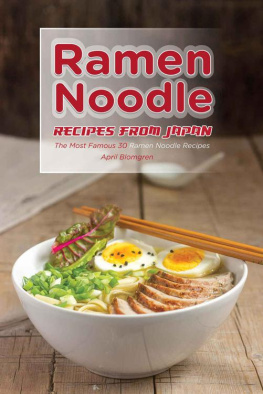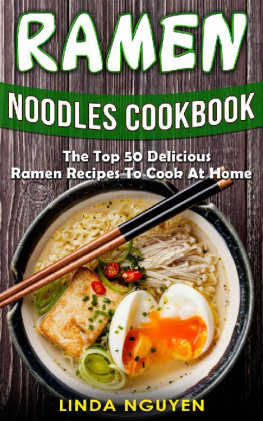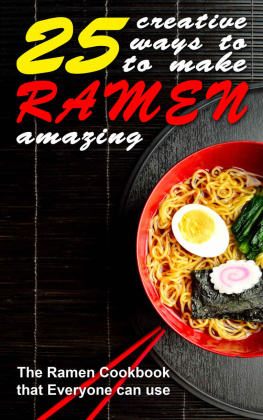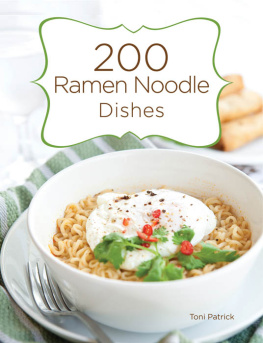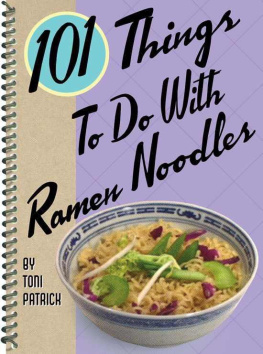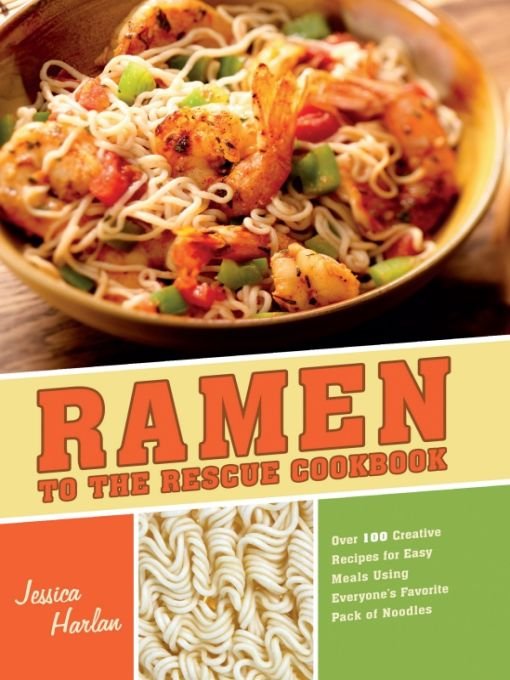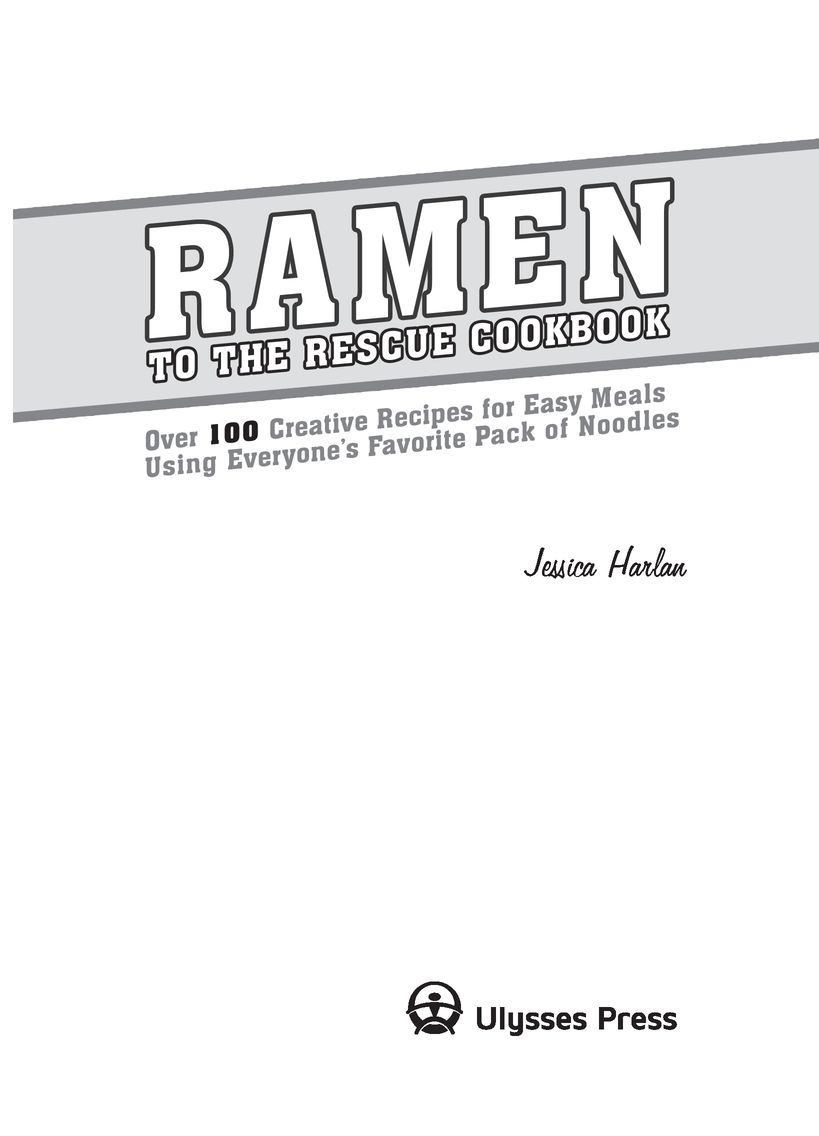Table of Contents
To Chip, the sous chef in my kitchen and in my life,
and
to Sadie and Gillian, the best taste testers a cook could ever hope for.
ACKNOWLEDGMENTS
I am grateful to everyone who came along for the ride on this wonderful adventure of writing my first cookbookparticularly the team at Ulysses Press, who gave me this opportunity and were so pleasant to work with.
A hug to all of my friends in Atlanta, New York, Chicago, and elsewhere who chimed in with ideas, recipes, and encouragement. And a special shout-out to my virtual office mate Stacie McClintock, who sent me the e-mail that got this whole ball rolling.
A raise of the glass to my good friend Kelley Sparwasser, who let me tap into her endless font of fantastic ideas, and who helped me out with several recipes. And to her husband, Adam Wisniewski, for his wonderful Ramen Mary recipe.
Love to my parents-in-law, Joseph and Christina Harlan, who let me use their kitchen, their babysitting services, and their taste buds on countless occasions. And I am eternally grateful to my brother-in-law Steve Harlan, whos always got my back when it comes to legal matters.
And more love to my own parents, Judy and Greg Goldbogen, my most faithful supporters throughout my life, enthusiastically endorsing my decisions and ideas, and championing every accomplishment.
And finally, much love and gratitude to my family. To my husband, Chip Harlan, who is infinitely supportive and proud of me, who eagerly sampled every dish I set before him without ever uttering the words, Ramen, again? And to my daughters, Sadie and Gillian, who are thankfully the least picky eaters I know, and the best daughters I could possibly have wished for.
INTRODUCTION
The mere mention of ramen noodles is sure to elicit nostalgia. Many people have memories of living on those little packages of noodles and powdered soup seasoning when they were in college or as they tried to make ends meet on an entry-level paycheck.
And indeed, for the budget conscious, packaged ramen noodles are the perfect food: Theyre cheap (my local supermarket sells six for $1), fast (the noodles cook in 3 minutes), and filling.
Admittedly, ramen soup, with its salty broth and freeze-dried vegetables, can get a little boring after a while. And certainly the sodium-laden seasoning packet isnt really that great for you... but thats where this book comes in. You can take advantage of the convenience, low price, and speedy cooking time of instant ramen noodles but use your own fresh ingredients, sauces, and seasonings to create a multitude of different dishes. Veggie-laden stir fries, delicious soups, innovative appetizers, crisp salads, casseroles big enough to feed a crowdall these and more can be made with those cheap little packages of ramen noodles.
Instant ramen noodlesdubbed Space Ramhave been enjoyed even in outer space, brought on board the space shuttle Discovery by Japanese astronaut Soichi Noguchi in 1995. Nissin Foods and JAXA, the Japan Aerospace Exploration Agency, developed the Space Ram together in four flavors: shoyu, miso, curry, and tonkotsu.
And because the long curly noodles are part of our collective culinary experience, a dish made with ramen noodlesespecially when theyre used in an unconventional wayis sure to be quite a conversation starter.
So stock up on those little packages, because with Ramen to the Rescue in your hands, youre sure to find many more delicious uses for instant ramen noodles than you ever dreamed you would!
Ramen: A Brief Background
Although ramen noodles are typically thought of as a Japanese food, they actually have China to credit for their origin. After all, noodles and pasta originated in China thousands of years ago. According to one theory, in the early 1900s, Chinese cooks in a Tokyo restaurant created a brothy noodle soup called shina soba. Soba is a type of Asian noodle made with buckwheat, rather than the wheat flour that ramen noodles are made of.
RAMEN SOUP MINI RECIPES: 10 EASY WAYS TO JAZZ UP RAMEN
When you just feel like keeping it simple but still want to add some dimension to a bowl of ramen noodle soup, use one of these mini recipes to add just one or two ingredients to your dish.
Stir a handful of chopped scallions into the soup just before serving.
Sprinkle the soup with fresh cilantro or Thai basil leaves just before serving.
Stir in a squirt of Sriracha or other Asian hot sauce along with the ramen noodle seasoning packet.
Add about 1/2 teaspoon toasted sesame oil to the broth and sprinkle with toasted sesame seeds.
Stir in a handful of chopped firm tofu or cooked chicken before serving.
Add about 1/2 cup frozen edamame or frozen chopped spinach to the boiling water along with the noodles.
After adding the seasoning packet to the cooked noodles and broth, stir in 1 lightly beaten egg until the egg cooks, and add a dash of soy sauce. Or, top with a chopped hard-boiled egg, or a fried or poached egg.
Garnish the soup with a handful of mung beans or shredded cabbage and a squeeze of lime.
Sprinkle the soup with nori furikake (seaweed seasoning), to taste.
As the noodles cook, add sliced cremini mushrooms or reconstituted dried mushrooms, such as shiitake or oyster mushrooms, to the pan.
Shina soba became Japans most popular Chinese dish and was served all over the country, with different regions incorporating local ingredients to make the recipe their own. Later, the name ramen was coined; its the Japanese pronunciation of lo mein, the Chinese noodles.
In Thailand, sales of instant ramen noodles have been used as an economic indicator, dubbed the Mama Noodles Index. Skyrocketing sales of the countrys best-selling instant ramen brand, Mama Noodles, accurately predicted a weakening economy.
In 1958, Momofuku Ando of Nissin Foods developed a chicken-flavored instant ramen noodle product in an effort to provide an easy-to-produce, convenient food option for citizens in postwar Japan, where food was scarce and finances were strained. At first, Andos ramen was considered a luxury, since it was still more expensive for consumers than fresh Japanese udon noodles. But eventually people grew to appreciate the convenience, and soon other manufacturers of instant ramen noodles came on board with their own versions and flavors.
In the early 1970s, Ando developed another ramen innovation: packing the noodles in a polystyrene cup so they could cook in boiling water right in the package. The concept of instant ramen noodles spread worldwide, and several manufacturers opened factories in the United States, an ideal marketplace for a product of this kind, since Americans have such a need and appreciation for cheap, convenient food. Nissins ramen, sold under the names Top Ramen and Cup Noodles, is today one of the best-selling ramen brands in America, along with Maruchan, a brand started in California in 1977.
True ramen fans can visit the Momofuku Ando Instant Ramen Museum in Osaka, Japan. The museum includes a reproduction of the research shack where Ando perfected his recipe, as well as an exhibit of production methods, a display of ramen noodle products from around the world, a video of the manufacturing process, and a tasting room. Theres also a hands-on workshop where you can try making your own instant ramen noodles, from stirring up the noodle dough to drying the noodles in the flash-fryer, and another interactive exhibit where you can make your own instant noodle cup.



